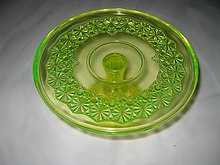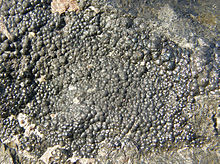Uranium
![]()
The title of this article is ambiguous. For other meanings, see Uranium (disambiguation).
![]()
U-235 is a redirect to this article. For the submarine see U 235.
Uranium (named after the planet Uranus) is a chemical element with the element symbol U and the atomic number 92. In the periodic table it is in the actinide group (7th period, f-block). Uranium is a metal whose all isotopes are radioactive. Naturally occurring uranium in minerals consists of about 99.3 % of the isotope 238U and 0.7 % of 235U.
Uranium gained particular importance after the discovery of nuclear fission in 1938. The uranium isotope 235U can be fissioned by thermal neutrons and is therefore - apart from the extremely rare plutonium isotope 239Pu, which can be produced from uranium - the only naturally occurring nuclide with which a self-sustaining nuclear fission chain reaction is possible. It is therefore used as a primary energy source in nuclear power plants and nuclear weapons.
History
Uranium was isolated from the mineral pitchblende in 1789 by the German chemistry professor and pharmacist Martin Heinrich Klaproth, who was living in Berlin at the time. It is named after the planet Uranus (and thus after the Greek sky god Uranos), which had been discovered eight years earlier (1781) by Friedrich Wilhelm Herschel. On September 24, 1789, Klaproth announced the discovery in an address to the Prussian Academy of Sciences. At first his discovery was called uranite, then renamed uranium in 1790. Klaproth had made his discovery while analyzing ore from the "Georg Wagsfort" mine at Wittigsthal near Johanngeorgenstadt in Saxony. He treated the ore with acid and heated it strongly. The result was a black powder, which he called uranium.
Klaproth had indeed identified a new element, but what he had obtained was not the element uranium itself, but an oxide. It was not until fifty years later in 1841 that the Frenchman Eugène Peligot succeeded in obtaining pure uranium metal. In the first half of the 19th century, uranium was extracted along with other minerals in St. Jáchymov, as well as in some mines in Cornwall, England.
Uranium compounds were used throughout the 19th century to colour glass and ceramics, giving a yellow-green colour ("anna green") to vases and decorative pieces, but also to everyday utensils such as bowls, glasses, etc. Glass manufacturers in Joachimsthal (Bohemia) used this technique as early as 1826. Glass manufacturers in Jáchymov (Bohemia) used this technique as early as 1826. Uranium was still used for glass colouring until the middle of the 20th century, when it was replaced by other, less harmful colouring minerals. Ceramic glazes containing uranium, ranging from orange to bright red, were used for tableware to architectural accessories.
In photography, uranyl nitrate was used until well into the 20th century for brown and red toning of slide plates, platinum images and bromide silver images.
The fact that uranium is radioactive was first discovered by Antoine Henri Becquerel in 1896.
Uranium was long considered to be the element with the highest atomic number that occurs naturally. In 1971, however, minute traces of the plutonium isotope 244Pu were detected, so that plutonium (Z = 94) replaced uranium as the known natural element with the highest atomic number.

Cake plate with foot, partly made of yellow-green uranium glass.

Site of the ore specimen of 1789 from pitchblende near Johanngeorgenstadt
Occurrence
→ Main article: Uranium deposit
Uranium does not occur naturally in pure form, but always in oxygenated minerals. Important uranium minerals include brannerite and uraninite (oxides), torbernite, heinrichite and carnotite (phosphates, arsenates and vanadates) as well as coffinite and uranophane (silicates). There are about 230 uranium minerals in total, which may also be of local economic importance. In sedimentary deposits, pseudomorphs of uranium minerals (mostly uraninite in the form of pitchblende) can also form after fossil wood or bacteria.
The two decisive factors for the distribution of the radioactive element uranium on earth are, on the one hand, the lithophilic character of the element and its different mobility in aqueous solutions under oxidizing and reducing conditions. The lithophilic character ensures that uranium accumulates in silicate-rich melts. Therefore, felsic igneous rocks such as granite as plutonite or rhyolite as vulcanite usually contain the highest concentrations of this element. The continental crust is the region of the Earth with the highest uranium contents averaging 2.5 ppm, while the oceaniccrust and mantle have uranium contents orders of magnitude lower. In igneous rocks, uranium is usually incorporated into accessory minerals such as zircon or monazite, which can therefore be used to date the age of the rocks very well.
The different solubility of uranium under oxidizing or reducing conditions in solutions is the second decisive factor for the distribution of the element and plays a major role in the formation of uranium deposits. Under oxidizing conditions (UO22+), uranium is relatively mobile in aqueous solutions, whereas under reducing conditions (U4+) it is sparingly soluble. Therefore, redox limits are often deposit controlling factors for the element.
Based on the above factors and several others, there is a wide range of uranium deposits from magmatic hydrothermal to sedimentary types. Important individual types are distinguished by the IAEA.
The highest uranium contents are achieved in unconformity-bound deposits with average uranium contents of 0.3 to 20 %. These also currently represent the two largest uranium producers. The largest single uranium resource on earth is Olympic Dam with a proven uranium content of over 2 million tonnes at average uranium contents of about 0.03%. The world's first industrial-scale uranium mine in Jáchymov (Czech Republic) produced from hydrothermal veins.
The natural reactors of Oklo in Gabon and a neighbouring uranium deposit are a special case: It is known that chain reactions occurred there in a natural environment over thousands of years about 1.5 to 2 billion years ago, in the course of which plutonium isotopes were also produced.
In normal soil, uranium occurs as a trace element. The US Agency for Toxic Substances and Disease Registry (ATSDR) estimates that the top 33 cm of soil in an area of one square mile of land contains an average of about 4 tons of uranium, or about 1.5 tons per square kilometer.
Uranium bound in complexes is also a ubiquitous element in the hydrosphere. The uranium concentration in seawater is about 3.3 µg/l compared to the sometimes much lower concentrations in rivers (0.03 µg/l in the Amazon to 3.9 µg/l in the Ganges). This shows that uranium is enriched in seawater. German rivers generally have uranium concentrations between about 1 and 3 µg/l. The source of the uranium lies in the geogenic structure of the areas drained by the rivers, e.g. surface waters from bogs may contain higher uranium concentrations, and is thus of natural origin. Only in exceptional cases are uranium concentrations in rivers due to human influence, e.g. the use of uranium-containing phosphate fertilizers and uranium mining (Zwickauer Mulde: approx. 10 µg/l). Uranium can be found in Germany in unaffected groundwater in concentrations of less than 1 to more than 100 µg/l. Regular consumption of drinking water with elevated uranium levels can lead to the occurrence of kidney cancer. For this reason, the World Health Organization (WHO) recommends a limit value of 30 µg/l for drinking water.
According to the International Atomic Energy Agency (IAEA), the largest uranium ore reserves are in the USA, Niger, Australia, Kazakhstan, Namibia, South Africa, Canada, Brazil, Russia, Ukraine and Uzbekistan.
Uranium is also contained in traces in hard coal and lignite. The coal used annually worldwide for power generation contains, among other things, about 10,000 t of uranium and 25,000 t of thorium, which are either released into the environment or accumulate in power plant ash and filter dust. There are therefore already isolated efforts to extract uranium from power plant ash.
The relationship between elevated uranium levels in mineral and drinking waters and the geology of the groundwater storage rocks was investigated nationwide for the first time in 2009. It was found that elevated uranium levels are predominantly linked to formations such as red sandstone or Keuper, which themselves have geogenically elevated uranium levels. However, locally, uranium contents from agricultural phosphate fertilization have already leaked into the groundwater, because rock phosphates contain 10-200 mg/kg uranium, which can lead to an input of approx. 5 g/ha/a uranium in the case of proper fertilization.

Uranium ore (pitchblende)
Questions and Answers
Q: What is uranium?
A: Uranium is a chemical element (a metal) on the periodic table with an atomic number of 92.
Q: How many isotopes of uranium are there?
A: There are three different isotopes of uranium, which have different numbers of neutrons in their nuclei. The most common is Uranium-238, followed by Uranium-235 and then the rarest, Uranium-234.
Q: What is pitchblende?
A: Pitchblende is the main ore that is mined for uranium.
Q: How can uranium be used in nuclear reactors and weapons?
A: By making a nuclear chain reaction, it turns the uranium-235 into uranium-236 and splits the nucleus into two smaller nuclei. This process is called nuclear fission and creates lots of heat which can be used to make steam in nuclear reactors or for making explosions with nuclear weapons.
Q: Is depleted uranium radioactive?
A: Depleted uranium has had its uranium-235 taken out so it's less radioactive than natural uranium but still slightly radioactive.
Q: What color does natural unrefined uranium appear as?
A: Natural unrefined uranium appears as a shiny white metal, but usually seen in its oxide form which is black. Spent or partially spent fuel rods kept underwater can glow blue due to Cherenkov radiation.
Search within the encyclopedia